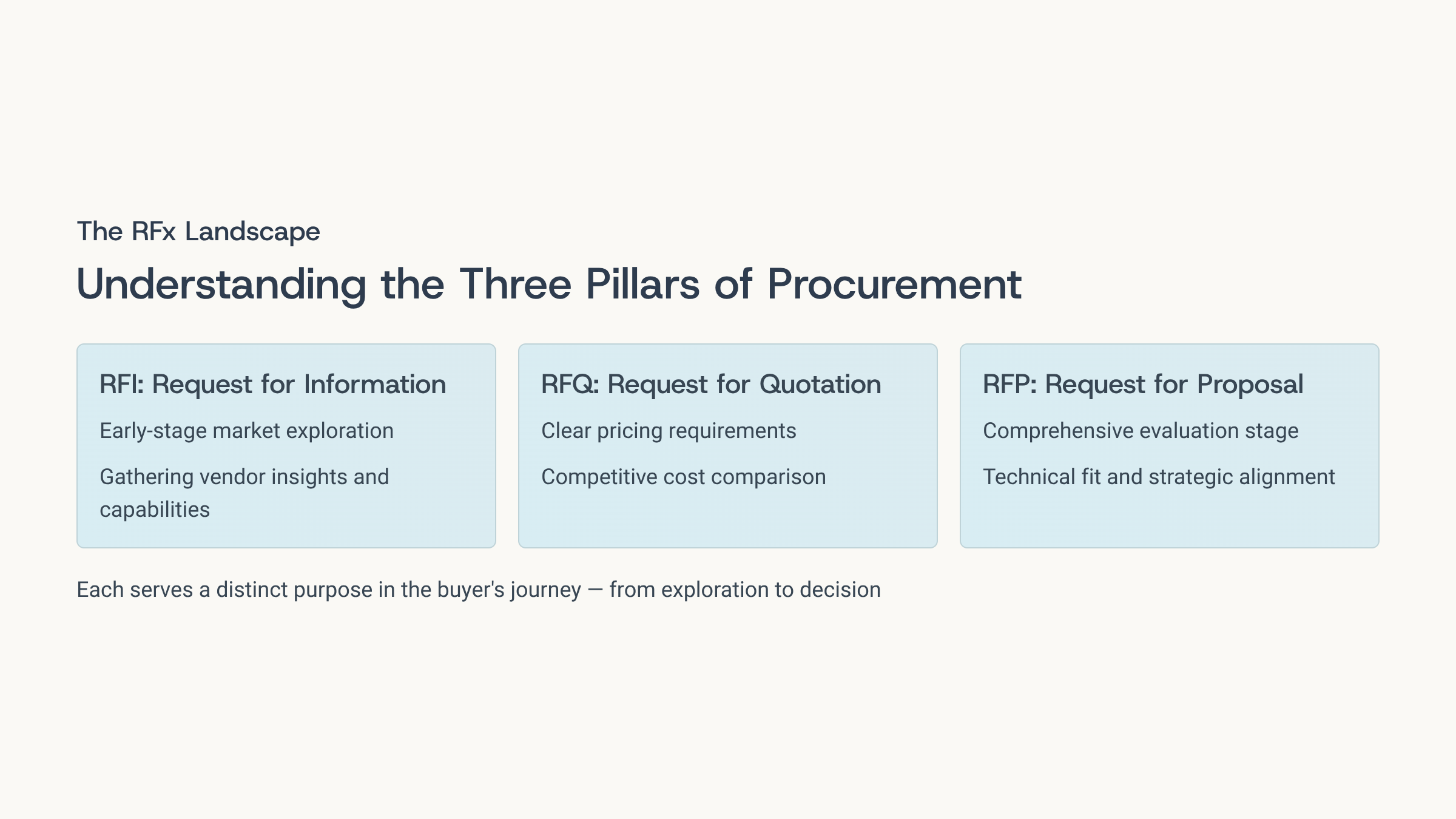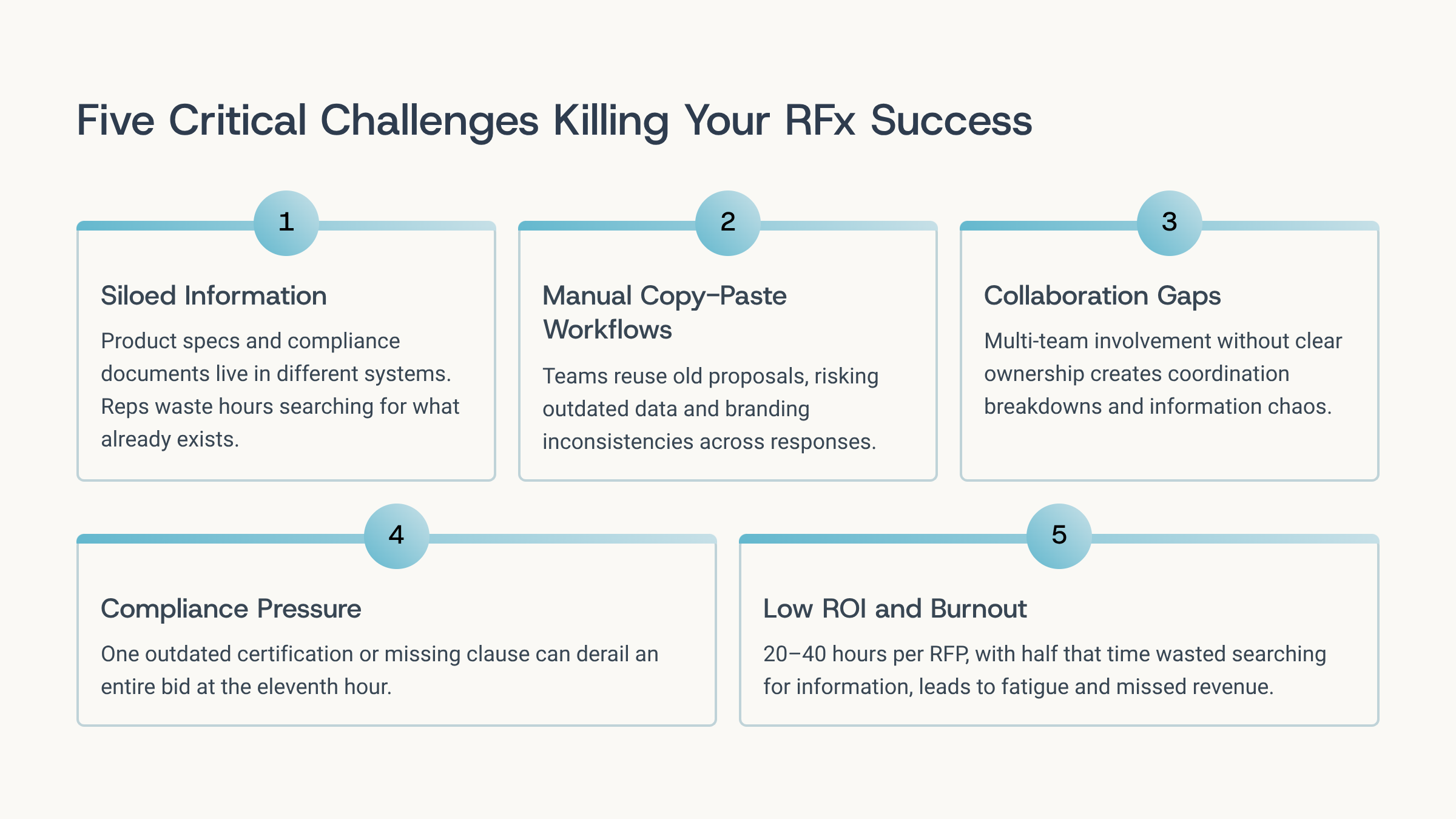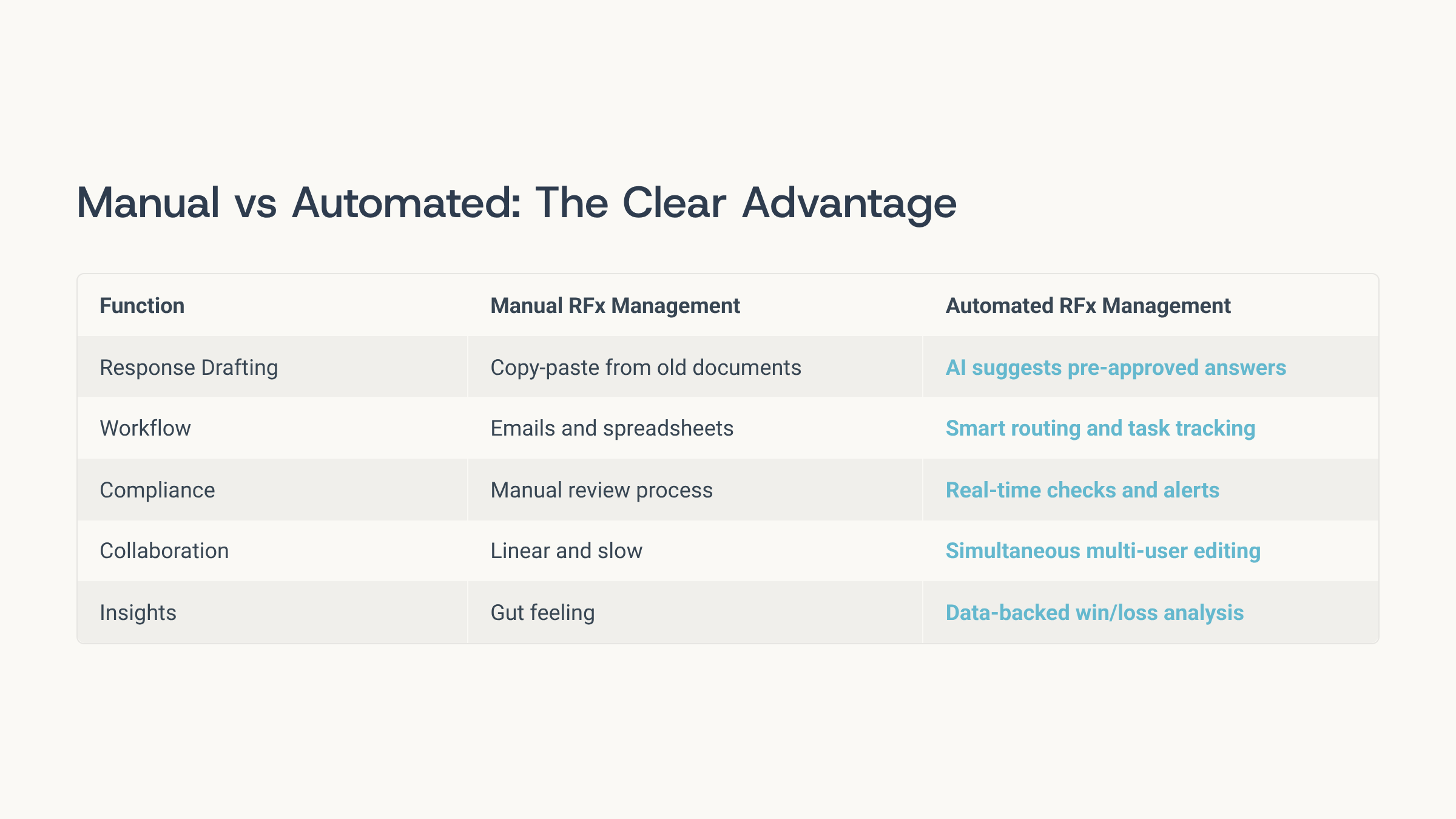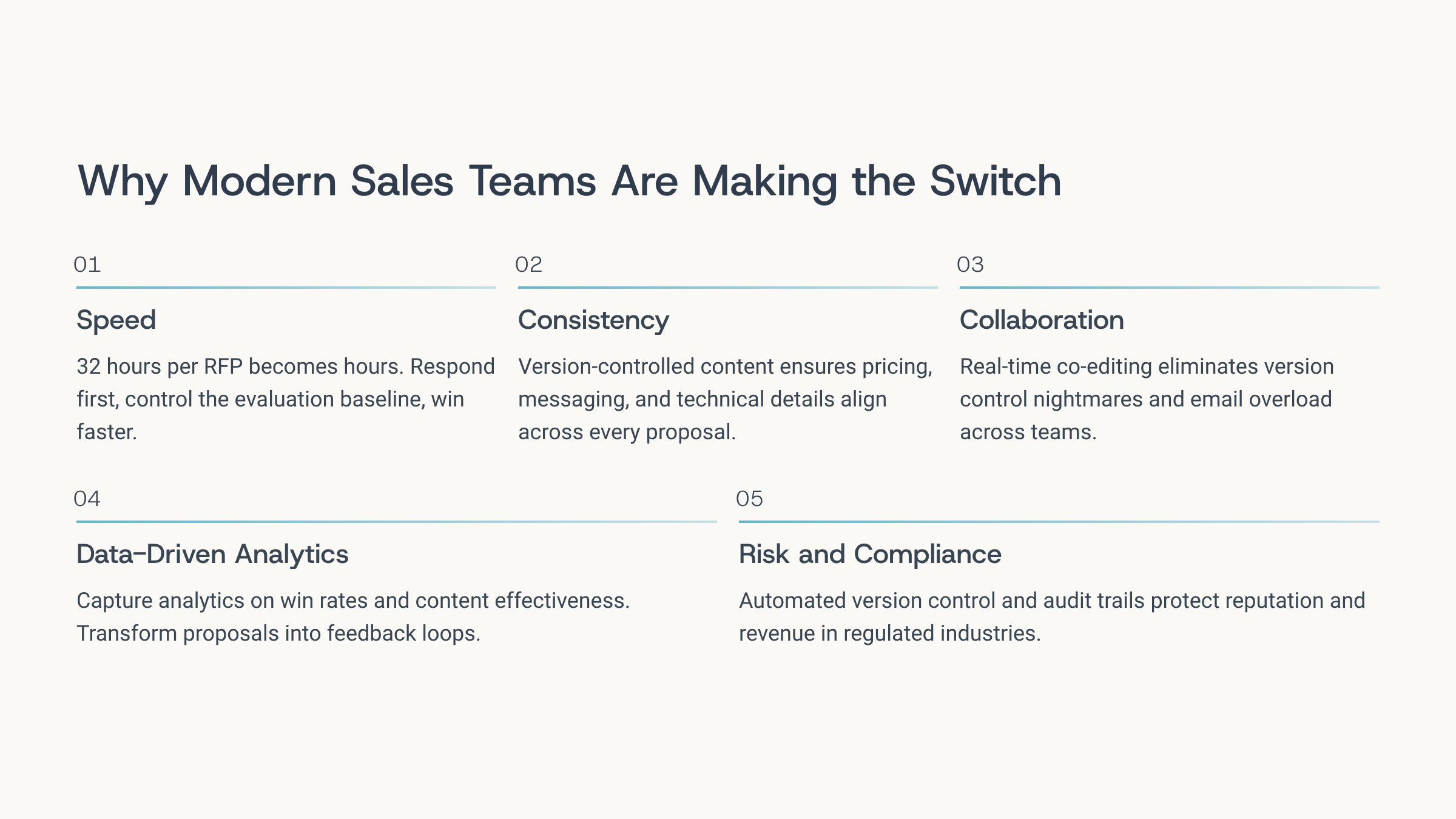What is RFx Response Management?
Article written by
Kate Williams

INSIDE THE ARTICLE
SHARE THIS ARTICLE
Summary
Managing RFPs, RFIs, and RFQs separately is draining your sales team and killing deals. This blog breaks down how RFx response management solves the chaos—bringing consistency, speed, and revenue impact through a unified platform. Learn from real transformations, discover what features matter, and build a scalable process that turns RFx from a bottleneck into a win engine.
A few months ago, a sales leader told me, “Kate, every RFP feels like déjà vu — same scramble, different deadline.”
That line stuck with me. Because for most sales teams, RFPs aren’t just opportunities but survival drills.
But what if the process wasn’t the enemy?
What if your team could respond to RFIs, RFQs, and RFPs with confidence, clarity, and time to spare?
That’s what modern RFx response management enables: less firefighting, more strategy, and a smoother path from request to revenue. Let's get to the whole picture.
What Is RFx?
Before we talk about managing RFx, let’s talk about what it actually is.
RFx is an umbrella term that covers three familiar procurement processes:
- RFI (Request for Information): Sent early in the buying cycle to collect general insights about available solutions and vendors. Think of it as a “market scan.”
- RFQ (Request for Quotation): Sent when the buyer knows what they need and wants clear, competitive pricing.
- RFP (Request for Proposal): The final, most detailed stage where buyers evaluate proposals based on technical fit, service quality, and strategic alignment.
In short, RFI = exploration, RFQ = pricing, and RFP = decision.
These processes are designed to help buyers make informed choices, but for sales teams, they often translate to 80-hour response marathons, document chaos, and endless internal ping-pong.

What Is RFx Response Management?
RFx Response Management is the structured, tech-enabled process of organizing, standardizing, and optimizing how organizations respond to RFIs, RFQs, and RFPs.
Instead of juggling shared drives, spreadsheets, and frantic email threads, teams use centralized platforms that handle response drafting and version control, automated content recommendations, approval workflows, collaboration between sales, product, and compliance teams, and analytics for win/loss insights.
It’s essentially turning chaos into a streamlined process that saves time, energy, and money.
According to Icertis, organizations with structured RFx response systems experience 40% faster turnaround times, 60% fewer manual errors, and up to 50% higher win rates.
That’s not just productivity at your fingertips, but predictability that helps organizations run their revenue engines.
Challenges in RFx Response Management
RFx requests were designed to streamline procurement. But for sales teams, they often do the opposite. Here are a bunch of reasons why:
1. Siloed Information
Critical content like product specs, case studies, and compliance clauses lives across different systems. Sales reps waste hours searching for or recreating what already exists. The time is gone, efforts are wasted, and the deals have already slipped. That not only impacts their work but can even demotivate them.
2. Manual Copy-Paste Workflows
Teams just casually copy-paste available data from anywhere and everywhere, reusing old proposals, risking outdated data, and causing branding inconsistencies.
3. Collaboration Gaps
RFx always involve multiple teams, including sales, finance, legal, engineering, etc., which makes the whole process even more chaotic without structured processes. Lack of clear ownership or workflow automation, coordination breakdowns, and the chinese whisper of information—everything creates chaos and more chaos only.
4. Compliance Pressure
One outdated certification or missing clause can derail an entire bid. Compliance checks that happen at the last minute is like a tightrope that can break the deal at any moment. The pressure gets real especially for the reps who face the clients directly.
5. Low ROI and Burnout
Teams spend a minimum of 20–40 hours per RFP when done manually, with nearly half of that time wasted searching for information that has to be found from the past bunch of files or gathered from all the people and teams involved around the organization. This is not just difficult but also creates fatigue, missed deadlines, and missed revenue, altogether.

What Is Automated RFx Response Management?
Automation disrupts the RFx game completely. It simplifies the whole process from receiving an RFx to hitting the send button and later tracking the whole deal, like it's a cakewalk. Wondering how?
The automated RFx response management uses AI, templates, and centralized knowledge bases to handle all the repetitive tasks in RFx management while keeping human oversight for strategic decisions.
Here’s a complete picture of how it works:
Function | Manual RFx Management | Automated RFx Management |
|---|---|---|
Response Drafting | Copy-paste from old docs | AI suggests pre-approved answers |
Workflow | Emails, spreadsheets | Smart routing and task tracking |
Compliance | Manual review | Real-time checks and version alerts |
Collaboration | Linear and slow | Simultaneous multi-user editing |
Insights | Gut feel | Data-backed win/loss analysis |
This automation of the RFx management process reduces drafting time and improves accuracy. It removes all the friction involved and makes the entire process seamless.

Why Modern Sales Teams Are Adopting RFx Management Platforms
Most sales teams still juggle disconnected documents, outdated content, and slow review cycles that drag down deal velocity. That’s why modern revenue teams are embracing RFx management platforms that unify automation, compliance, and collaboration into one streamlined workflow.
Here’s what’s driving this shift and why it’s redefining how high-performing sales teams operate.
1. Speed = Pipeline Velocity
Speed wins deals. Research shows that creating a single RFP response takes 32 hours, or roughly 25 minutes per question. That’s nearly a full workweek lost per proposal.
RFx management platforms eliminate repetitive work with pre-approved templates, reusable content libraries, and automated workflows. Responses that once took days now take hours, giving your team the agility to respond first, set the evaluation baseline, and control the pace of the deal.
2. Consistency Builds Credibility
Buyers notice inconsistencies, and they remember them. When your pricing, messaging, or technical details vary between proposals, it signals internal misalignment and creates doubt.
RFx management platforms centralize approved content in a version-controlled knowledge hub, ensuring every proposal uses the same tone, terminology, and up-to-date data. This content governance builds brand credibility and reinforces confidence across every buyer touchpoint.
3. Collaboration Without Chaos
Proposal creation is inherently cross-functional. Without the right system, it quickly descends into email overload and version chaos.
Modern RFx platforms solve that with real-time collaboration, enabling multiple contributors to co-edit responses, add comments in context, and route approvals automatically.
Sales, legal, and product teams can all work from the same live document, reducing back-and-forth and avoiding the dreaded “final_final_v7.docx.”
4. Data-Driven Improvement
RFx platforms capture analytics on win rates, response effectiveness, and content reuse, helping teams see which answers close deals and which ones need improvement. This data transforms the proposal process into a feedback loop. Over time, your content gets sharper, your messaging stronger, and your hit rate higher.
Considering RFPs account for 35% of annual revenue for many organizations, this level of insight is a competitive edge, not a nice-to-have.
5. Risk and Compliance Alignment
In regulated industries, one outdated statement can cost credibility or compliance.
RFx systems mitigate this risk with automated version control, compliance checks, and audit trails.
Legal and security teams can approve sensitive sections, lock down specific phrasing, and monitor every change.
Every submission is policy-aligned, audit-ready, and enterprise-compliant, protecting both your reputation and your revenue.

Benefits of Modern RFx Response Management
Modern RFx response management goes beyond digitizing procurement. It connects people, processes, and data into one intelligent workflow. The result is faster responses, higher compliance, and smarter decisions. Here’s how organizations benefit when they adopt modern RFx management software:
1. Unified Collaboration Across Teams and Stakeholders
Procurement never happens in isolation. Modern RFx platforms centralize communication between sourcing, finance, legal, and business units, creating a single workspace for collaboration.
Instead of juggling email chains or waiting for feedback, stakeholders work in real time with built-in commenting, version control, and document sharing. This alignment ensures every input is timely, accurate, and tied to the right stage of the RFx process.
2. Efficiency Without Compromise
Automation removes friction, not control. RFx software streamlines repetitive tasks such as formatting responses, scheduling reminders, and maintaining templates, freeing up teams for strategic work.
Pre-configured workflows, automated alerts, and reusable content libraries standardize execution while maintaining precision. The outcome: shorter cycle times, consistent quality, and greater operational velocity.
3. Structured Data and Institutional Knowledge
Procurement knowledge often lives in inboxes or personal drives until someone leaves. A centralized RFx system captures every version, answer, and decision trail in a structured format.
This digital memory ensures continuity, reduces onboarding time for new team members, and eliminates the risk of knowledge loss. With searchable records and contextual metadata, stakeholders can retrieve any historical RFx instantly.
4. Policy Compliance by Default
Compliance doesn’t have to slow things down. Built-in approval workflows, role-based permissions, and standardized templates ensure every action adheres to procurement policy.
Instead of acting as a bottleneck, the software functions as an intelligent checkpoint catching errors, enforcing validation rules, and generating auditable trails automatically. Teams stay compliant without sacrificing agility.
5. Risk Reduction and Audit Readiness
Regulatory audits and risk assessments demand defensibility. RFx software delivers that through automated audit logs, version control, and consistent evaluation methods.
Every change, score, and supplier interaction is recorded, reducing exposure to errors or omissions. Procurement leaders gain confidence knowing that every decision is traceable, explainable, and policy-aligned.
6. Tangible Cost Savings and Operational ROI
Digitization doesn’t just make processes smoother; it saves real money. By minimizing rework, reducing delays, and cutting manual errors, RFx automation directly impacts procurement ROI.
Organizations report up to 40% faster response cycles and double-digit cost reductions, all while improving the quality and accuracy of their supplier engagements.
7. Data-Driven Insights and Reporting
Procurement isn’t just about transactions; it’s about intelligence. RFx platforms capture granular data on supplier performance, category trends, and cost patterns.
Built-in dashboards help teams track win rates, identify bottlenecks, and benchmark vendor performance. This data-driven visibility transforms procurement from a reactive function into a strategic business enabler.
8. Diversity and Inclusion Enablement
Modern procurement must balance efficiency with equity. RFx tools support supplier diversity by capturing certifications, monitoring engagement metrics, and surfacing diverse vendors during sourcing cycles.
This transparency strengthens ESG reporting and ensures underrepresented suppliers receive fair visibility, embedding inclusion into the sourcing DNA of the organization.
9. Faster Time to Contract and Execution
When workflows are centralized and communication is seamless, the time between request and contract shrinks dramatically. RFx tools automate document routing, enable parallel reviews, and ensure that all stakeholders operate from the latest version. It results in faster vendor onboarding, earlier project kickoffs, and accelerated revenue realization.
10. Scalability, Security, and Future-Proofing
Procurement evolves. So should your platform. Modern RFx management systems integrate seamlessly with ERP, CRM, and contract lifecycle tools, enabling data flow across the enterprise.
Enterprise-grade security, role-based access, and compliance certifications (SOC 2, ISO 27001, GDPR) ensure every document and interaction stays protected. As regulations and market dynamics evolve, the platform scales with your business, future-proofing procurement excellence.
By automating the manual, centralizing the scattered, and securing the sensitive, the RFx platform transforms procurement into a data-driven, audit-ready, and innovation-ready operation.
Features to Look Out For in Modern RFx Management Tools
When choosing an RFx management platform, the question isn’t “What does it automate?” but “How well does it align people, processes, and policies?”. Modern tools do more than digitize requests—they build trust, enforce discipline, and connect every stakeholder in your procurement ecosystem.
Below are the capabilities that define a best-in-class RFx solution:
1. Automated RFx Workflows
A modern RFx tool automates every stage of the sourcing cycle from request creation to final evaluation. Built-in routing rules, approval hierarchies, and auto-notifications eliminate manual follow-ups. This not only saves time but also ensures every request moves forward with zero bottlenecks or missed deadlines.
Why it matters: Automation doesn’t just boost speed; it safeguards consistency, compliance, and visibility across all sourcing activities.
2. Centralized Data Repository
Procurement thrives on information and collapses without it. A centralized repository consolidates supplier data, past responses, pricing history, and qualification documents into one searchable hub. Teams no longer chase scattered files or depend on individuals for context.
Why it matters: Institutional knowledge becomes accessible, auditable, and ready to train future AI or analytics engines.
3. Real-Time Collaboration and Communication
Sourcing, legal, finance, and business units rarely work in silos, so your RFx tool shouldn’t either. Real-time collaboration lets multiple contributors co-edit proposals, leave comments, and track progress simultaneously. Built-in chat and activity feeds keep discussions contextual and documented.
Why it matters: It breaks down departmental barriers, reduces miscommunication, and speeds up decision cycles.
4. Evaluation and Scoring Automation
An advanced RFx system standardizes supplier evaluation through automated scoring models. Teams can assign weights, compare responses side-by-side, and flag inconsistencies instantly. This brings data-driven objectivity to supplier selection, reducing bias and manual workload.
Why it matters: Consistent scoring improves fairness, accuracy, and transparency in procurement decisions.
5. Regulatory Compliance and Audit Readiness
RFx tools with built-in compliance frameworks ensure every submission meets internal and external standards, from policy adherence to regulatory audit trails. Version tracking, expiry management, and access logs make compliance a continuous process, not an afterthought.
Why it matters: Audit readiness becomes an automatic outcome of your workflow, not a scramble before deadlines.
6. Seamless Integrations with Enterprise Systems
Look for solutions that integrate securely with CRMs, ERPs, Contract Lifecycle Management (CLM), and Supplier Relationship Management (SRM) systems. These integrations ensure data flows automatically between departments without redundant entry or sync errors.
Why it matters: Integration turns your RFx software from a standalone app into a connected node in your digital procurement stack.
7. Supplier Accessibility and Engagement
Inclusive procurement depends on supplier accessibility. Cloud-based portals let vendors submit bids, clarify requirements, and track progress transparently. Built-in diversity tracking and qualification modules further enhance supplier visibility and inclusion.
Why it matters: Accessibility drives diversity, trust, and stronger supplier partnerships.
8. Contract and Post-Award Management
Modern RFx tools don’t stop at award decisions. They link directly to contract lifecycle management, tracking obligations, renewals, and compliance milestones automatically.
Why it matters: Procurement teams maintain visibility from sourcing to contract execution ensuring accountability beyond the award.
9. Management Reporting and Analytics
Procurement success is measurable. Dashboards surface metrics like win rates, supplier performance, response times, and cost savings. With predictive analytics, teams can even forecast outcomes and identify process inefficiencies.
Why it matters: Analytics transform procurement from a reactive cost function into a strategic performance engine.
10. Transparency, Control, and Scalability
Every stakeholder, from buyers to executives, gains a single source of truth. With detailed audit trails, approval hierarchies, and access controls, organizations can grow confidently while maintaining governance and transparency.
Why it matters: The best RFx tools scale with your organization while keeping control uncompromised.
Quick Feature Checklist
Core Capability | Why It’s Critical |
|---|---|
Automated workflows | Reduces manual errors and delays |
Centralized data | Improves visibility and governance |
Evaluation automation | Standardizes supplier scoring |
Compliance management | Ensures audit readiness |
Integrations | Enables end-to-end data flow |
Supplier accessibility | Promotes inclusion and efficiency |
Collaboration | Aligns multi-department input |
Contract management | Connects sourcing to execution |
Reporting and analytics | Provides data-driven insights |
When comparing RFx management tools, prioritize those that learn, govern, and evolve, not just automate. The right platform builds a more transparent, compliant, and intelligent procurement culture.
Conclusion
Responding to RFPs will never be “fun.” But it can absolutely be frictionless.
When your sales team has a unified knowledge hub, automated workflows, and AI that does the heavy lifting, those once-dreaded documents start feeling like opportunities again.
You stop firefighting and start forecasting.
You stop reacting and start winning.
That’s the real promise of automated RFx response management platforms like SparrowGenie, giving teams the time and tools to do what they do best: sell with confidence and clarity.
Ready to see how AI can transform your RFP process?
Product Marketing Manager at SurveySparrow
A writer by heart, and a marketer by trade with a passion to excel! I strive by the motto "Something New, Everyday"
Frequently Asked Questions (FAQs)
Related Articles

30+ Sales Automation Mistakes And How to Avoid Them

RFP Response Automation Tools: From 10-Day Nightmares to 2-Day Victories
